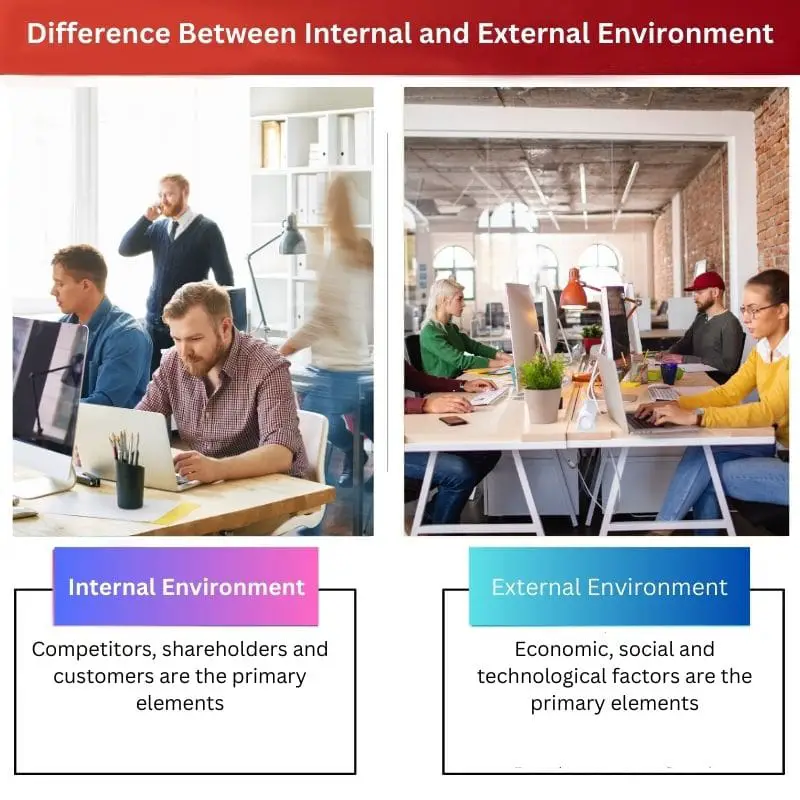The internal environment of an organization encompasses its internal resources, such as employees, culture, and infrastructure, influencing its operations and performance. On the other hand, the external environment involves factors outside the organization’s control, such as economic conditions, market trends, and regulatory changes, which can impact its overall success and strategic decisions.
Key Takeaways
- The internal environment includes factors that affect its operations, such as employees, management, and company culture.
- The external environment comprises factors outside the organization that can impact its success, including competitors, regulations, and economic conditions.
- Organizations must adapt and respond to internal and external environments to maintain competitiveness and achieve long-term success.
Internal vs External Environment
The internal environment of an organization includes all factors within its boundaries, like its resources, employees, and management, that can be controlled or influenced. The external environment includes factors outside the organization, like market trends, competition, or legal regulations, which are beyond its direct control.

It is to be understood that, Internal Environment has certain factors that are directly associated with the company’s growth in the market, and the External has multiple factors that are directly and indirectly associated with the growth or decline of the whole organisation.
Comparison Table
| Feature | Internal Environment | External Environment |
|---|---|---|
| Scope | Factors within the organization | Factors outside the organization |
| Control | Can be influenced or controlled by the organization | Largely beyond the organization’s direct control |
| Impact | Directly affects the organization’s operations and outcomes | Indirectly affects the organization by creating opportunities or challenges |
| Focus | Organizational structure, culture, resources, policies, leadership | Market conditions, economic climate, legal regulations, technology, social trends |
| Examples | Management style, employee skills, production facilities, financial resources | Customer preferences, competitor actions, government policies, technological advancements |
What is Internal Environment?
The internal environment of an organization refers to the factors, resources, and conditions within the organization that influence its operations, performance, and strategic decisions. Understanding the internal environment is crucial for effective management and strategic planning. Let’s delve into various aspects of the internal environment with detailed H3 and H4 headings.
Organizational Structure
The organizational structure defines how tasks, responsibilities, and authority are distributed within the organization. It includes:
1. Hierarchical Structure
This refers to the levels of authority and decision-making within the organization. It outlines the chain of command from top management to lower levels, indicating who reports to whom.
2. Departmentalization
Organizations can be structured based on functions, products, geography, or customer segments. This aspect explores how different departments are organized to achieve specific objectives.
Corporate Culture
Corporate culture encompasses the shared values, beliefs, and norms within an organization. It plays a significant role in shaping employee behavior and overall organizational performance.
1. Values and Beliefs
Examining the core values and beliefs upheld by the organization provides insights into its ethical standards and principles.
2. Cultural Norms
Understanding the unwritten rules and norms within the organization helps in comprehending the expected behaviors and practices.
Resources and Capabilities
Organizations rely on various resources and capabilities to achieve their goals. This includes financial resources, human capital, technology, and more.
1. Financial Resources
Analyzing the organization’s financial health, including revenue, expenses, and budget allocations, is crucial for assessing its financial stability.
2. Human Capital
Examining the skills, knowledge, and expertise of the workforce is essential for evaluating the organization’s human resources.
Internal Processes
Internal processes refer to the systems and procedures implemented within the organization to carry out its daily operations efficiently.
1. Operational Efficiency
Evaluating how well the organization’s processes and systems function to deliver products or services.
2. Innovation Processes
Assessing the organization’s ability to innovate and adapt to changing market conditions is critical for long-term success.
Leadership and Management
Leadership and management practices within the organization impact its direction, decision-making, and overall effectiveness.
1. Leadership Style
Examining the leadership style adopted by top management helps understand how decisions are made and communicated.
2. Management Practices
Analyzing the effectiveness of managerial processes, such as planning, organizing, and controlling, provides insights into the organization’s management capabilities.

What is External Environment?
The external environment refers to the broader context in which an organization operates, encompassing various factors and forces that influence its functioning and performance. Understanding the external environment is crucial for strategic planning and decision-making within an organization.
Components of the External Environment
1. Economic Environment
The economic environment includes factors such as economic growth, inflation rates, exchange rates, and overall economic stability. Organizations must analyze these elements to anticipate potential impacts on their operations and financial performance.
2. Political and Legal Environment
Political and legal factors involve government policies, regulations, and political stability. Changes in legislation or government actions can significantly affect businesses, requiring organizations to adapt to new legal frameworks.
3. Socio-Cultural Environment
This aspect considers societal values, demographics, lifestyles, and cultural trends. Organizations need to align their strategies with prevailing social norms to effectively connect with their target audience.
4. Technological Environment
The technological environment encompasses advancements and innovations that can impact industries. Organizations must stay abreast of technological developments to remain competitive and identify opportunities for improvement.
5. Ecological and Environmental Factors
Growing concerns about environmental sustainability and climate change have led to increased scrutiny of organizations’ ecological impact. Companies are now expected to adopt environmentally friendly practices and contribute to sustainable development.
6. Global Environment
In an interconnected world, businesses operate across borders. The global environment includes factors like international trade, global markets, and geopolitical events, influencing the strategies and operations of multinational corporations.
7. Competitive Environment
The competitive environment involves the dynamics within an industry, including the level of competition, market share distribution, and the bargaining power of buyers and suppliers. Organizations must assess their competitive position to formulate effective strategies.
8. Demographic Factors
Demographic factors include population size, age distribution, and ethnic composition. These factors influence market demand, workforce availability, and consumer preferences.
Importance of Analyzing the External Environment
Understanding the external environment is crucial for strategic management because:
- Risk Mitigation: Anticipating external challenges helps organizations prepare for potential risks and uncertainties.
- Opportunity Identification: Analyzing the external environment helps identify market opportunities, technological advancements, and emerging trends that organizations can leverage for growth.
- Strategic Planning: Organizations can align their strategies with external factors to gain a competitive edge and ensure long-term sustainability.
- Adaptability: A dynamic external environment requires organizations to be flexible and adaptive, adjusting their strategies to meet changing conditions.

Main Differences Between Internal and External Environments
- Internal Environment:
- Controlled by the Organization: The internal environment is within the control of the organization and its management.
- Employees and Culture: It includes factors such as organizational culture, employee morale, and internal policies.
- Structure and Resources: The organizational structure, available resources, and infrastructure are part of the internal environment.
- Leadership and Management: The leadership style, management practices, and decision-making processes are internal factors.
- External Environment:
- Outside the Organization’s Control: The external environment consists of factors beyond the direct control of the organization.
- Market Conditions: External factors include market trends, competition, and the overall economic situation.
- Legal and Regulatory Environment: Laws, regulations, and government policies impact the external environment.
- Technological and Social Changes: External forces encompass technological advancements, social trends, and changes in consumer behavior.
- Suppliers, Customers, and Stakeholders: Relationships with suppliers, customer demands, and interactions with various stakeholders are external influences.






